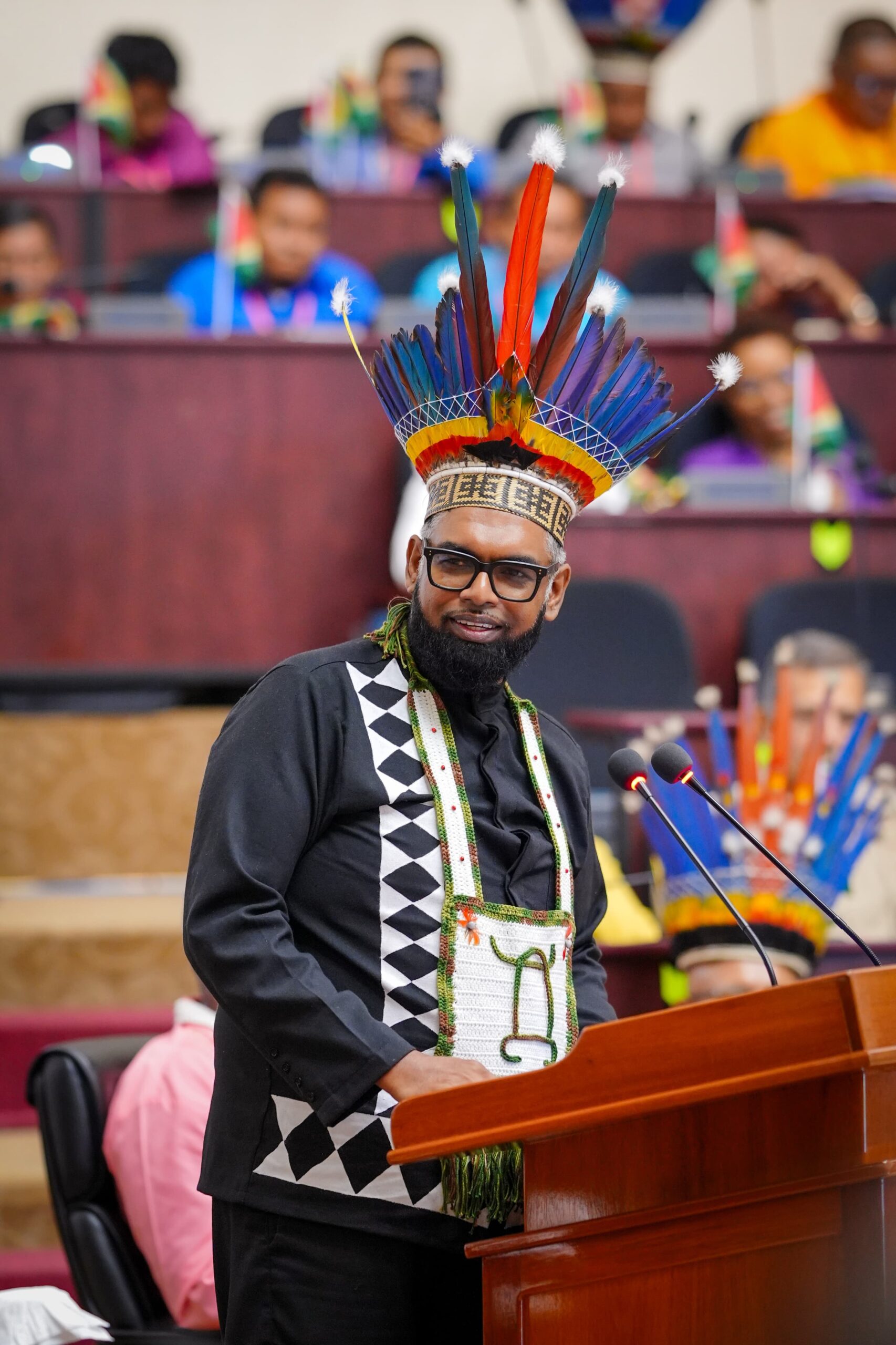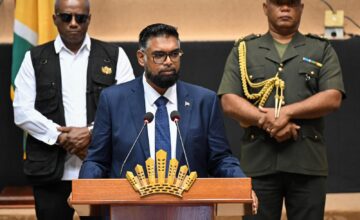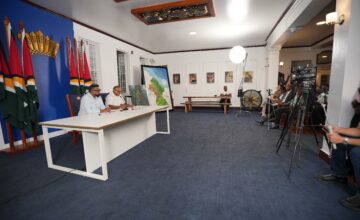
Georgetown, Guyana (May 20, 2025) – His Excellency President Dr Irfaan Ali underscored his Government’s full commitment to supporting the sustainable development of all Amerindian communities and their residents across the country.
This, the President announced, will be supported by the continued expansion of sustainable development and transformation in key sectors, including health, education, and agriculture, and will be complemented by a more than 35% increase in the annual Presidential Grants to Amerindian communities this year.
The Head of State delivered the keynote address at the opening of the National Toshaos (NTC) Conference at the Arthur Chung Conference Centre on Monday, where he announced that this year, the Presidential Grant would be increased to $532m from $395m in 2024.
“We, in this Government, are committed not only to the expansion of our economy but, importantly, we are committed to the expansion of opportunities in every village; in every single corner of our country.”
President Ali emphasised that his Government will also advance Amerindian land titling, maintain the nominal value of the Low Carbon Development Strategy (LCDS) resources that are transferred directly to indigenous communities, create more jobs, and drive sustainable development for Amerindians and their communities.
“We will invest in food security, we will invest in financial empowerment, not only by increasing grants, subsidies, and other direct financial transfers to your community but through economic literacy, through financial literacy, and through the creation of various initiatives that will enable you in your villages to earn more, to be empowered, and to create great opportunities—just like we are doing now with cage farming, fish farming, and honey production.”
Development across the regions
The Head of State also spoke extensively about his Government’s accomplishments across indigenous communities in key sectors, including health and education.
In Region One (Barima-Waini), the President noted that before 2020 (when his Government took office), 100% of neonatal complications were referred out of the region, less than 30% of medical supplies were available, fewer than 23 community health workers were trained, zero surgeries were conducted in the region, and there were no facilities with vaccine refrigeration, oxygen generation, or telemedicine.
Due to robust investment in healthcare across the regions, as of 2024, there were zero neonatal referrals out of the region; less than 1% of patients needed to be medically evacuated; more than 16 ATVs, six ambulances, pickups, minibuses, motorbikes, and over 25 boats and engines were procured to transport patients and health workers; and medication availability increased to 95%.
“This is your record. You should be proud of this, because it is under your leadership in the villages and communities that you are also achieving these groundbreaking developments and advancements.”
The President added that between 2015 and 2020, fewer than 60 healthcare professionals were trained in the region. This, he pointed out, contrasts sharply with his Government’s accomplishment of training more than 330 health workers between 2021 and 2024. Additionally, between 2015 and 2019, the Mabaruma Hospital completed only 15 surgeries, compared to more than 570 surgeries in 2024.
“I applaud our health workers, who are serving in these regions. These are the facts. This is the reality. This is what none of us can escape—the factual position.”
At Moruca District Hospital, between 2015 and 2020, zero surgeries were performed, compared to 85 elective surgeries in 2024 alone. The President said that over 10,000 persons from the region had their eyes tested, and 7,012 were provided with spectacles. Almost 1,000 women were screened for HPV, and over 56 vaccination sites and 17 telemedicine facilities were developed.
“Today, we are generating 2,000 large and 1,050 small cylinders of oxygen as of January 2024, right in the region. Oxygen is now distributed to 10 additional sites in this region. These are the developments that we talk about.”
These advancements, the President noted, will be complemented by the completion of the new Moruca Regional Hospital and the expansion of services at Mabaruma Regional Hospital.
“We are going to continue this investment—the expansion of lab services in many villages across the region, the implementation of the electronic health record system, the establishment of a regional pharmaceutical bond, and the expansion of the transportation network for patients. We are going to build more accommodation for doctors, nurses, and medical practitioners, and by 2030, we are going to eliminate malaria in this region.”
In Region Seven (Cuyuni-Mazaruni), the President highlighted that more than 45 different forms of transportation had been procured. The availability of medical supplies increased from 45% between 2015 and 2019 to 85% as of 2024. Whereas in 2020 there were only two annual health outreaches to the region, in 2024 alone, 24 health outreaches were conducted, benefiting almost 10,000 patients.
“We have expanded the services available in this region by leaps and bounds. We have added new medical specialities, both in equipment and human resources. Forty-three new community health workers have been trained and added to the staff, along with more nurses, more doctors, and more patient care assistants—most of whom come directly from your communities in this region. We invested in their training. We invested in their development.”
Between 2015 and 2020, 39% of patients required medical evacuation to the GPHC. By 2024, this had dropped to 3%.
At Aishalton and Annai, zero ophthalmology surgeries had been conducted, and there were no facilities equipped with vaccine refrigerators, oxygen production, or telemedicine. Between 2015 and 2020, 90% of all critical pregnancies had to be transferred out of the region. Today, fewer than 2% require transfer out of the region, the President pointed out.
“My friends, we will continue to invest in healthcare in this region—not only at the health centres, by upgrading them to polyclinics, and not only by expanding the range of services available, but by ensuring that we build a state-of-the-art hospital in Bartica. We are going to invest more in transportation, more in training, and more in human resource development to ensure that you receive quality healthcare.”
In Region Nine (Upper Takutu-Upper Essequibo), the availability of medication between 2015 and 2019 was 45%, compared to 90% in 2024. There were no specialist outreaches between 2015 and 2020, compared to eight in 2024 alone, reaching more than 55,000 people across the region.
The President also stated that between 2020 and 2024, more than 550 residents in the region were trained in healthcare.
Before 2020, no surgeries were performed at Lethem Regional Hospital. In 2024 alone, 1,216 surgeries were completed.
“Today, the services at Lethem Hospital are of such high and exceptional quality that we are now receiving a record number of patients from Brazil who are coming to Guyana to have their surgeries done here. Before, it was the reverse. These are the real facts on the ground—driven, yes, by the vision, ideas, and hard work of the PPP Civic Government—but, importantly, implemented by the strong leadership of our health workers, our community workers, our regional teams, and you, the community leaders.”
More than 2,000 people in the region have also benefited from the Government’s eye test and free spectacles programme. The President also stated that more than 25 vaccination sites, including a regional cold storage facility, had been constructed. Today, the region is generating more than 2,100 large and 1,050 small cylinders of oxygen.
In Region Eight (Potaro-Siparuni), in 2020, more than 360 cases were referred to GPHC, whereas this year, only half of those cases were referred to GPHC, with 94 people transferred to the Regional Hospital of Mahdia.
Between 2015 and 2020, the availability of medical supplies was 55%. Today, between 2020 and 2024, the average availability of medical supplies and medicines is 93%.
The Head of State added that between 2015 and 2019, healthcare training was virtually non-existent, whereas in the last two years alone, more than 136 people have been trained.
“In Region Eight, you can be assured—you can trust us—to complete the new Kato Hospital; to upgrade the major district hospital with ICU services, a 24-hour operating theatre, and an emergency service upgrade. We have the upgrade of Monkey Mountain. Dozens of villages across the region will see upgrades from clinics to polyclinics. You will have the implementation of telemedicine and the electronic health record system as we continue to build quality healthcare for the people of Region Eight.”
Education
The President also underscored his Government’s achievements in education in indigenous communities.
He pointed out that as of December 2024, 83% of all teachers across Regions One, Seven, Eight, and Nine were fully trained, and his Government was working assiduously to increase the number to 100%.
“Importantly, this 83% represents a transformative increase from 2020. In 2020, fewer than 43% of teachers in the hinterland communities were trained. By the end of 2024, we have reached 83%.”
He further stated that the percentage increase in new recruits who are trained and available in hinterland communities is now more than 318%, and the total number of hinterland teachers currently stands at 2,435.
The NTC Conference this year is being held under the theme: ‘Robust Governance for Sustainable Village Development’.


